 When you say the word ‘ranch’ you generally think of the west with its wide open spaces and endless plains. You certainly don’t think of the east coast, and much less likely the east end of Long Island, an area generally associated with coastal resort living and fishermen. But that is exactly where the oldest ranch in America is found—at the very tip of Long Island, 118 miles east of NYC, in the village of Montauk…right down the road from me.
When you say the word ‘ranch’ you generally think of the west with its wide open spaces and endless plains. You certainly don’t think of the east coast, and much less likely the east end of Long Island, an area generally associated with coastal resort living and fishermen. But that is exactly where the oldest ranch in America is found—at the very tip of Long Island, 118 miles east of NYC, in the village of Montauk…right down the road from me.
To be fair, ‘oldest ranch’ might be a stretch. In 1658, the year Deep Hollow Ranch claims to have been established, the land was used for pasturage of cattle, and certainly in that way it has been in continual use. At that time, the pastures were leased for grazing from the Montaukett Indians. There is an earmark register with the Town Clerk here in East Hampton (of which town Montauk village is a part) that goes all the way back to the 1660s. Up until around 1700, the value of two cows was equal to a small house, so this source of wealth had to be protected. With this in mind, by 1747, three houses were built on the road from East
Hampton village, where most of the settlers actually lived. These residences were to accommodate travelers and the keepers, men of prominent families who could ensure the integrity of the shared pasture. The houses were numbered according to the order one passed them on the road from the west. Third House eventually became Deep Hollow Ranch.
While the First House keeper was responsible for entering all the cattle in the common pasture on a list and repairing fences, and Second House was responsible for sheep, it was left to the Third House Keeper to have a list of all stock kept on the fatting field, which is now the land around Deep Hollow. He had to ride out Tuesdays and Fridays to check on the cattle, and the great June round-up was also held at Third House. The first cowboy? The Town Trustees fixed the number of cattle permitted on the pasture according to the condition of the grass, with one horse equaling two head of cattle, and one beast equaling seven sheep. Eventually, as many as 6,000 head of cattle, horses and sheep grazed this fourteen mile stretch between East Hampton and Montauk, May through November; they came from
as far as seventy miles away. If a landowner did not use his full allowance, he was permitted to rent out his share of the pasturage. In winter, the cattle would be driven back to the individual farms on a date fixed by the Town Council. If the weather held, this could be as late as December, and Thanksgiving, at a time when it was still a moveable feast, was not held locally until after the cattle drive.
During the Revolution, the British sailed in to replenish their supplies. Some 2,000 cattle were removed to safety while 3,000 sheep remained. One hundred and forty men came to protect the livestock, and stood on a hilltop where they could clearly be seen by the British in their ship. They repeatedly turned their coats several times to fool the enemy into thinking there were more men than sheep. Hence, ‘turncoats.’ While the British left on that occasion, residents were less lucky in the War of 1812 when the English came ashore.
Third House burnt down in 1806 and was rebuilt, being restored once more in the 1950s. In 1879, Arthur Benson bought 10,000 acres for $151,000 and proceeded to make Third House his residence, building an extension. His idea was to force the Montaukett off the land and make the area into a resort. But at a time when it took some six hours to travel the distance from East Hampton alone, riding through mosquito and fly infested dunes, the idea never took off. In 1895, the Long Island Railway was extended into Montauk with the thought that it might become a major seaport, easing the port of New York.

Teddy Roosevelt (lower right) & Rough Riders at Camp Wikoff, 1898–courtesy C. Frank Dayton collection, East Hampton Library
The seaport never developed but the railway reduced the cattle drive to the pasture. Benson’s heirs sold off his land, mostly to the federal government for various service bases. In 1898, when Teddy Roosevelt returned after the Spanish American War, the land was used to accommodate more than 29,000 men. It was then called Camp Wikoff, and Third House was TR’s office. The Rough Riders were eventually disbanded here.
In the 1920s, Benson’s heirs sold more land to entrepreneur Carl Fisher. ‘Mr. Miami’ envisaged a Miami of the north, and Indian Field, the main field across from Third House, became a polo field for a time. Fisher was impeded by the LI State Park Commission seizing nearly 2,000 acres by eminent domain in 1924, and he later lost his fortune in the 1929 stock market crash. Eventually, in 1936, a very young Phineas Dickinson III leased the land with the help of his family and brought in 150 head of cattle. Deep Hollow Ranch became a cattle and guest ranch—and at times cocktail lounge and restaurant—
and in October a hunting lodge, with the exception of the WWII years. Dickinson contacted Texas ranches to supply his cattle, and for ten years this went on with the cattle being shipped by rail followed by a four mile cattle drive from the station to the ranch. The West had come east.
Deep Hollow Guest and Cattle Ranch passed through several hands over the ensuing years. A brochure I have advertises ranch rides, moonlight rides and range riding as well as archery, deep sea fishing, golf, hunting, swimming and tennis—not all of it on the premises, of course. I see advice on what to wear and “Trained cowboys will
instruct the novices in riding ranger fashion, roping and even ‘bull-dogging’” In the 1930s, the rate for a two bedroom private cottage with meals was $104 weekly!
Since that time, the approximately 1,157 acres around Third House, including Indian Fields, have gone through various permutations as first Indian Field County Park, Montauk County Park and Theodore Roosevelt County Park. In 1971, nineteen year old Randy Leaver, a former ranch hand at Deep Hollow, bought the
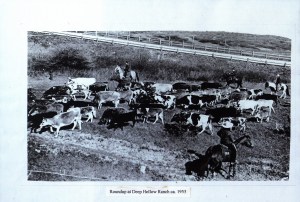
Round-up at Deep Hollow, ca. 1955 courtesy Shank Dickinson Collection in the LI Collection, East Hampton Library
concession to the ranch, which now sits in the county park. Married to one of the Dickinson daughters, he developed the ranch pretty much as it is today. He brought in fifty head of Black Angus cattle and leased another 4,000 acres for trail riding through the dunes. Chuckwagon rides and Texas BBQs became part of the attraction, as did rodeos—
fighting local ignorance about ‘animal cruelty’ in such events. The Leavers also instituted Back at the Ranch benefit concerts with the help of neighbor Paul Simon. These went on for many years with notaries such as Jimmy Buffett, Billy Joel and The Highwaymen as attractions.
Just as western ranchers have land disputes and upsets with the BLM and other government bodies, so Leaver had a dispute with the local Board in the early 2000s. Saying he was spending more on lawyers than on the ranch, he eventually decided to retire
and passed on the concession five years ago to its present managers, Pat and Cate Keogh. Cate is a local Montauk gal while Pat is purebred Colorado cowboy and rodeo star. The Keoghs run Corriente/Longhorn cattle and train cutting horses, in addition to managing the ranch. Wagon and trail rides through the dunes are supplemented by a pony camp in the summer and Native American presentations for schoolchildren. While they live a short distance down the road with their three children, they are hoping to expand the ranch with a Center for Wildlife Rescue, and renovations to the old cabins and Third House for future guest use. It looks as if Deep Hollow Ranch is set for quite some time to come.
My sincere thanks to Robin Strong, Archivist at Montauk Library, for her help and guidance in the research for this article. I would also like to thank Steve Russell Boerner and Andrea Meyer, Librarians and Archivists, for their help and guidance at East Hampton Library. Finally, my thanks to Cate Keogh for taking the time to show me around Deep Hollow Ranch and share its history with me.
There is one rather unpleasant footnote to this story. While researching in Montauk Library, Archivist Robin Strong pointed out to me a stamped sentence at the bottom of the 1930s ranch brochure: “The clientele is restricted to Gentiles” She was as amazed and disgusted as I at such blatant anti-Semitism. Happily, such restrictions are long gone.

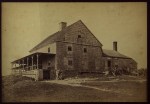

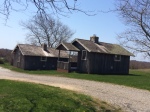
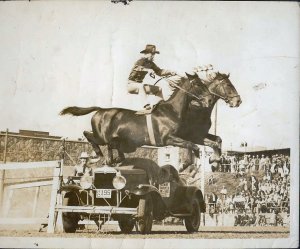
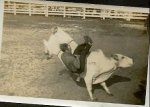
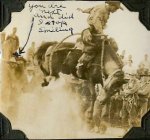
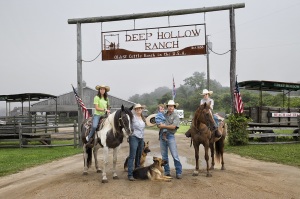


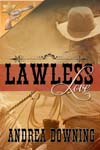












What a wonderful tale. I learned something new and thing its great.
LikeLike
Learn something new every day! It was certainly fascinating to research it. Thanks for stopping by.
LikeLike
How cool! Being a Colorado girl with 50 years of firmly-planted midwestern rural roots, this story piqued my curiosity. There are places like that here in Colorado (not as old, of course) and my family’s farm has a nearly 200-year history in the Missouri Ozarks. These are the kind of places you walk into and you can feel that important things happened there, even if you don’t know what those important things are!
LikeLike
Well, Susabelle, maybe you should research what those important things were? Seems to me there’d be dang good material for a book in that history. When we lived in England, our home for several years was 3 lead-miners’ cottages knocked into one–dating from the 1500s. We even had the deeds from that period. Fascinating.
LikeLike
I do not write historicals, or I would! 🙂 I’m definitely a contemporary writer. But I love history in general, especially when it is personalized. That’s probably why I like author Sandra Dallas.
LikeLike
I haven’t read Sandra Dallas but will keep her in mind. Thanks for the tip.
LikeLike
Sandra Dallas is a Colorado writer. I discovered her some years ago, long before I lived here. Read The Persian Pickle Club first.
LikeLike
Thanks Susabelle!
LikeLike
How fascinating, Andi! Loved reading the history of the ‘ranch’ and the ingenuity of the early owners/workers.
LikeLike
Yes they were pretty ingenious early on in the guest ranching they got in Cowboys from out west to make it more western ranch. At one time there were three from Kansas they called Kansas Incorporated 😊
LikeLike
I enjoyed your post and reminder that history has taken some odd turns at times. What fun to have the West right down the road from you!
LikeLike
It certainly does feel like the west–except of course for the ocean and sand dunes. But since the 1930s everyone working down there has dressed western and it has a very western feel–especially now with the cutting horse business .
LikeLike
I certainly enjoyed this post, Andrea. While I’d heard about this ranch, I didn’t really know much about it. Thanks for sharing.
LikeLike
Caroline, I’m really curious as to where you’d heard of Deep Hollow Ranch? Have you been up that way? Tell all!
LikeLike
Andrea, what a wonderful post! Interesting to see that it always comes back to being a ranch.
LikeLike
And is likely to remain so by the look of things!
LikeLike
And here I thought California had some of the oldest ranches, Andrea. Absolutely loved this post! Thanks for the history lesson. 🙂
LikeLike
Glad to be of service, Mary! Thanks for stopping by.
LikeLike
Very interesting! A bit of history I knew nothing about. Thanks, Andi. A side note here: The Cottonwood Inn where you and Cristal plan to stay when you visit Kansas in June (home of the Kansas Incorporated cowboys at Deep Hollow) is across from the golf course. In the early days, I’m told, folks who wanted to keep their milk cows in town, pastured them there, bringing them in each evening to milk and returning them to the pasture after milking in the morning. I thought that a quaint piece of history. A very small piece, but quaint.
LikeLike
Thanks for that, Eunie. I should explain to anyone else that happens to be reading this that the Deep Hollow Ranch employed three cowboys from Kansas in the 1970s whom the then-manager, Randy Leaver, always referred to as “Kansas Incorporated” I’ll look at that golf course when I get there, Eunie, and try to imagine it with cows!
LikeLike
And to think it wasn’t Texas! Have always associated the east coast with fishing and small farms, so I learned something, too. Then again, when you think about the history of the east in general, their civilization developed way sooner than “ours” (I’m from Colorado) on many fronts.
LikeLike
I think that the general association with the word ‘ranch’ is the west but as you point out, the East developed far earlier and there were ranches quite early on in upstate New York as well as Florida–in addition to this one, of course!
LikeLike
Fascinating post, Andrea. Like Nancy Oswald, I’m struck by the timing of it all. Most of the Spanish missions in and around San Antonio (where I live) were not yet built by the time Deep Hollow’s history was well underway. Question: What is an “earmark register” mentioned in the second paragraph. I don’t think I’ve heard that term.
Karen Casey Fitzjerrell (PS: How well I remember the beautiful cozy library in East Hampton! Lucky you!)
LikeLike
As they say, Karen, timing is everything! Joking aside, to answer your question, they didn’t brand the cattle early on, they earmarked them as is still done today as you well know (at least I think you know; certainly the working cattle ranches I’ve been on ear mark–a cut here or there, whatever, though some tag now, don’t they?) So that’s it–the register is of the different ear marks to decipher whose cattle is whose. Or do you call it something else down in Texas?
LikeLike
Did the cattle originate in England or Ireland? Where did the cattle come from? Thank you. Very good information.
LikeLike
When the settlers moved down from Connecticut to the East End of Long Is., the cattle and their belongings came with them. I imagine that these were descendants, if not the same cattle, they would have brought on ships from their homelands, predominantly wherever in Britain they had lived.
LikeLike
The claim to oldest cattle ranch is false. The white ranch here in Alachua county Florida was established before the pilgrims landed in 1620. It has been continuously operating since its founding. Please know your history. Florida is the birthplace of ranching and cowboys. Also, there have been cattle in Alachua county since 1528 with the narvaez expedition. Please give historical credit where it is due.
LikeLike
The oldest continous ranch in not only America, but north America, is the White ranch in Alachua county Florida. It was founded in 1574 on the black sink prairie. It is also the oldest farmland. Refer to whiteranch.org to be enlightened. The south was settled first. By 1650, there were 28 cattle ranches in Alachua county. This is the birthplace of the cowboy, not New York.
There have been cattle here since 1528.
Please retract your story.
LikeLike
If you had read my post, which by the way was written some years ago, you would find I said, “To be fair, ‘oldest ranch’ might be a stretch. In 1658, the year Deep Hollow Ranch claims to have been established, the land was used for pasturage of cattle, and certainly in that way it has been in continual use.” I researched this and used the information available to me. I agree you have a claim but I certainly will not retract the story.
LikeLike
And, by the way, you wrote to me three years agao regarding this.
LikeLike
Pingback: Amazing Things to do in Montauk (Hamptons Getaway Guide) - Bobo and ChiChi